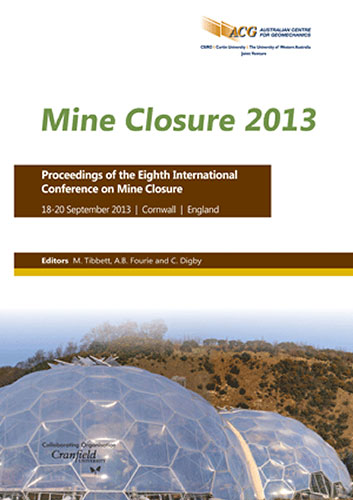Mine dumpology – mine tips as a scientific and public resource

|
Authors: Jeffrey, K Paper is not available for download Contact Us |
DOI https://doi.org/10.36487/ACG_rep/1352_03_Jeffrey
Cite As:
Jeffrey, K 2013, 'Mine dumpology – mine tips as a scientific and public resource', in M Tibbett, AB Fourie & C Digby (eds), Mine Closure 2013: Proceedings of the Eighth International Seminar on Mine Closure, Australian Centre for Geomechanics, Cornwall, pp. 25-30, https://doi.org/10.36487/ACG_rep/1352_03_Jeffrey
Abstract:
There is increasing international appreciation of mining heritage – and nowhere more than in Cornwall. UNESCO recently recognised the historical importance of its mining archaeology with World Heritage designation. Old engine houses, mines, tramways, dressing floors, kilns and associated processing facilities are now accorded protection and recognised for their uniqueness on a world scale. These are worthy of preservation, but another important aspect of mining site legacy is missing. Mine dumps are unfortunately named, implying worthlessness, when they are actually the repository of mine uniqueness. It is straightforward to replace historical mine buildings, indeed restoration often does, with currently available skills and materials. But not so mine dumps; it is impossible to replicate the unique nature of their contents – host rocks, ore assemblages, textures, and spatial variability created by the mining process. Worldwide, mining sites are still being systematically destroyed in the name of beautification, redevelopment, social rejuvenation and environmental remediation. Over the last 50 years Cornwall has suffered a catastrophic loss of its mining history through this process, focussing on picture-postcard engine houses and creating a theme park mentality to its mining history. The dumps, however, are as important, if not more so, than the buildings. Mine dumps have a wide range of potential stakeholders, including companies, scientists, mineral collectors, historians and mine heritage enthusiasts. This paper proposes a new field of study – one fitting between mining history, economic geology and forensic industrial archaeology. Mine dumpology: the study of mine tips using approaches drawn from geological fieldwork, mineralogy, archaeology, history, forensics and diverse laboratory sciences.
References:
Green, D.I. (1987) The minerals of the Meadowfoot smelter, UK Journal of Mines and Minerals, Vol. 2, p. 36.
Huang, L., Zhou, W.H., Hallberg, K.B., Wan, C-Y., Li, J. and Shu, W.S. (2011) Spatial and temporal analysis of the microbial community in the tailings of a Pb-Zn mine generating acidic drainage, Applied and Environmental Microbiology, Vol. 77(15), pp. 5540–5544.
Lugg, A. and Probert, D. (1996) ‘Mundic’-type problems: a building material catastrophe, Construction and Building Materials, Vol. 10(6), pp. 467–474.
Ñancucheo, I. and Johnson, D.B. (2012) Acidophilic algae isolated from mine-impacted environments and their roles in sustaining heterotrophic acidophiles, Frontiers in Microbiology, Vol. 3, pp. 1–8.
Newsome, D. and Dowling, R.K. (2010) Geotourism: opportunity and tourism significance, in Global Geotourism Perspectives, R.K. Dowling and D. Newsome (eds), Goodfellow Publishers Limited, Oxford.
Parsons Brinkerhoff (2012) St Austell, St Blazey and China Clay Area Regeneration Plan: Sustainability Appraisal of Land Use Alternatives, WHV285300JC – Final Draft, 86 p.
Pearman, G. (2009) 101 Things to Do with a Hole in the Ground, Post-Mining Alliance, Eden Project, Bodelva, UK.
Rawlings, D.E. and Johnson, D.B. (2007) The microbiology of biomining: development and optimization of mineral-oxidizing microbial consortia, Microbiology, Vol. 153(2), pp. 315–324.
Rollo, H.A. and Jamieson, H.E. (2006) Interaction of diamond mine waste and surface water in the Canadian Arctic, Applied Geochemistry, Vol. 21, pp. 1522–1538.
Sinkankas, J. (1961) Prospecting for Gemstones and Minerals, Van Nostrand, New York, 397 p.
US EPA (US Environmental Protection Agency) (2000) Abandoned mine site characterization and cleanup handbook, 910-B-00-001, Washington, DC, 129 p.
© Copyright 2024, Australian Centre for Geomechanics (ACG), The University of Western Australia. All rights reserved.
View copyright/legal information
Please direct any queries or error reports to repository-acg@uwa.edu.au
View copyright/legal information
Please direct any queries or error reports to repository-acg@uwa.edu.au